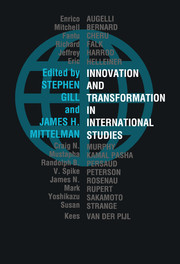Book contents
- Frontmatter
- Contents
- List of contributors
- Preface
- Acknowledgements
- Part I Rethinking and remaking the roots of global social and political theory
- Part II Political economy: the social and ecological anatomy of transformation
- 5 Ecology, political economy and the counter-movement: Karl Polanyi and the second great transformation
- 6 Braudelian reflections on economic globalisation: the historian as pioneer
- 7 Social forces and international political economy: joining the two IRs
- 8 Transnational class formation and state forms
- Part III Transformation, innovation and emancipation in global political and civil society
- Part IV Reflections on global order in the twenty-first century
- References
- Index of names
- Index of subjects
8 - Transnational class formation and state forms
Published online by Cambridge University Press: 05 July 2011
- Frontmatter
- Contents
- List of contributors
- Preface
- Acknowledgements
- Part I Rethinking and remaking the roots of global social and political theory
- Part II Political economy: the social and ecological anatomy of transformation
- 5 Ecology, political economy and the counter-movement: Karl Polanyi and the second great transformation
- 6 Braudelian reflections on economic globalisation: the historian as pioneer
- 7 Social forces and international political economy: joining the two IRs
- 8 Transnational class formation and state forms
- Part III Transformation, innovation and emancipation in global political and civil society
- Part IV Reflections on global order in the twenty-first century
- References
- Index of names
- Index of subjects
Summary
This chapter explores aspects of the process of transnational class formation of the capitalist class or bourgeoisie in historical perspective. It looks at forms of imagined community (Anderson, 1983) by which this class established a new identity literally outside the pre-existing community and outside the reach of prior social and political structures. Freemasonry, operating within and across a range of state–society complexes from the late seventeenth century on, serves as one model for such imagined communities supporting a class identity.
Bourgeois class formation itself was also subject to aspects of socialisation in the sense that separate bodies branched off from the broader class networks to assume a collective intellectual or planning function. The Rhodes/Milner group in the British empire, which was connected to the American ruling class, was the first of such bodies on a transnational level. Ultimately, all these structures serve(d) to reinforce the capacity of the capitalist ruling class to expand its mode of production to global dimensions and eliminate obstacles resisting such expansion; and, within its established sphere of influence, to raise the rate of exploitation of labour and shape social life and politics accordingly. Since this takes place in the context of struggle, there are inherent limits to these designs, and the development of capital itself upsets any particular pattern of exploitation by the contradictory advance of commodification and socialisation.
- Type
- Chapter
- Information
- Innovation and Transformation in International Studies , pp. 118 - 134Publisher: Cambridge University PressPrint publication year: 1997
- 5
- Cited by



